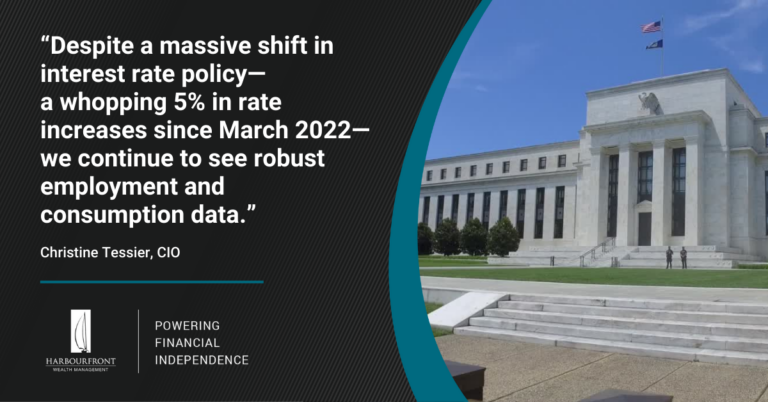The US Federal Reserve Holds Steady in Delicate Balancing Act
The US Federal Reserve announced this week that it will maintain the target range for the federal funds rate, deciding for the first time in over a year to keep the rate steady. Harbourfront’s Chief Investment Officer Christine Tessier shares her perspective on this announcement:
- The Fed gave two important signals yesterday. First, it held rates stable, committing to a Fed funds rate between 5.0% and 5.25%. Fed Chairman Powell provided hawkish guidance that two further increases could be expected in 2023. These seemingly opposing data points illustrate that the Fed feels that economic uncertainty remains high.
- The Fed is very data dependent. Many key data points driving the Fed’s decision, such as employment and inflation, are lagging indicators. The Fed is on watch to see how prior policy actions are affecting these two numbers. Over the past rate hiking cycle, the Fed has prioritized price stability in its policy decisions. It’s important to remember that this hiking action comes on the heels of many years spent in a low interest rate, deflationary environment.
- The Fed wants to quell inflation before letting up. So far, the Fed’s decision reflects the fact that economic indicators do not yet confirm that price stability is fully and absolutely under control. While inflation is steadily decreasing (i.e., the April US inflation print of 4.05% is moving downward), it remains above the long-term average of 3.28%.
It’s a delicate balancing act. I concur with the Fed’s view that uncertainty is high. At the global level, there are further factors that complicate the picture, i.e., the economic slowdown in China.
- Despite a massive shift in interest rate policy—a whopping 5% in rate increases since March 2022—we continue to see robust employment and consumption data. This helps explain why the Fed forecasts possible further rate hikes. It also suggests that a broad-based recession, as it is felt by everyday people, is not yet an imminent risk.
- When interest rates are rising, economic theory tells us that when the costs of production and consumption increase, we can expect a slow down in productivity (and eventually, employment). In periods of high inflation, central banks strive to slow the economy down enough to normalize prices, but not too much to cause a major recession. However, so far, this has not been the case; despite massive policy tightening, employment remains robust.
Why is this happening now? There are many economic factors that contribute to these challenges, but here are a few worth paying closer attention to:
- Major demographic shifts in employment. (a) The retirement of the baby boomer generation; and (b) the volume of immigration. These trends create robust employment and may be far more impactful that a rate change increase.
- Many inflationary trends are difficult to quantify. Re-on-shoring of global supply chains and green energy transitions are currently underway. These represent just a few examples of long-term supply-side situations that help keep inflation elevated yet are difficult to measure.
- Confidence that the Fed won’t let them fail. The economy continues to expect that the Federal Reserve will protect industries from failure, a type of addiction to Fed support. And although monetary policy has been tight, recent activity in the bank sector and the Federal Reserve role in supporting these challenges again act as loosening monetary policy, or printing money.

If you have questions about what this means for your portfolio, connect with your advisor.
Christine Tessier
Chief Investment Officer, Harbourfront Wealth Management
Disclaimer
I, Christine Tessier, have prepared this commentary to give you my thoughts on various investment alternatives and considerations which may be relevant to your portfolio. This commentary reflects my opinions alone and may not reflect the views of Harbourfront Wealth Management. In expressing these opinions, I bring my best judgment and professional experience from the perspective of someone who surveys a broad range of investments. Therefore, this report should be viewed as a reflection of my informed opinions rather than analyses produced by Harbourfront Wealth Management Inc.



A Temporary Truce: The US-China Trade War
14 May 2025